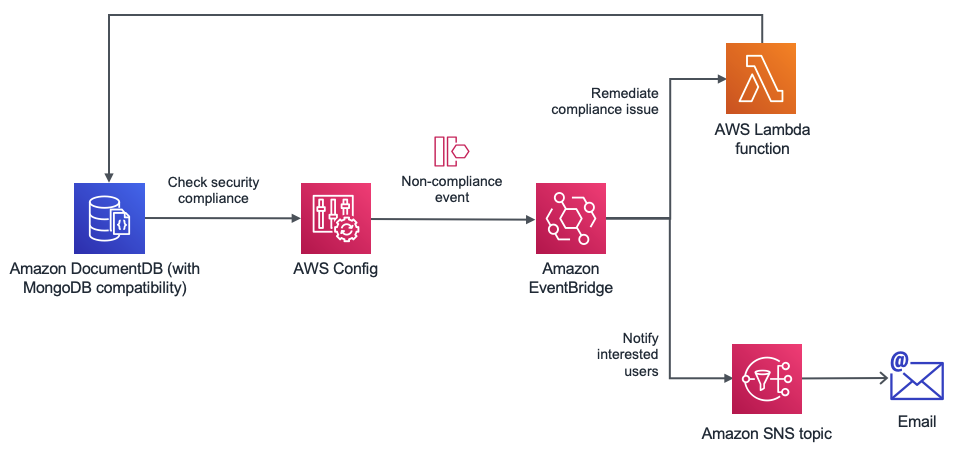AWS Database Blog
Category: Management Tools
Enforce configuration policies for your Amazon RDS databases using AWS Config
In today’s cloud-enabled enterprise, multiple teams take on the responsibility of creating and managing databases. The challenge that you may face is the enforcement of your company’s standard configuration policies—how do you make sure that all databases are following the database configuration standards consistently? This is where AWS Config can help. In this post, I […]
Send alerts on custom AWS DMS errors from Amazon CloudWatch Logs
AWS Database Migration Service (AWS DMS) is a widely used AWS service to migrate data into the AWS Cloud from on-premises databases or within AWS databases in the cloud. For smooth migrations using AWS DMS, it’s imperative to monitor the AWS DMS resources and tasks, specifically for errors and warnings. Monitoring AWS DMS task via […]
Best practices to deploy Amazon Aurora databases with AWS CloudFormation
Many organizations prefer infrastructure as code (IaC) for provisioning and maintaining IT infrastructure. With IaC, you can replicate DevOps practices for application code such as storing the infrastructure code in a source control system, automated testing, and automated deployment through a continuous integration and continuous delivery (CI/CD) pipeline. AWS CloudFormation is an IaC service that […]
Get started with Amazon RDS Custom for SQL Server using an AWS CloudFormation template (Network setup)
Amazon Relational Database Service (Amazon RDS) Custom is a managed database service for legacy, custom, and packaged applications that require access to the underlying operating system and database (DB) environment. Amazon RDS Custom for SQL Server automates setup, operation, and scaling of databases in the cloud, while granting access to the database and underlying operating […]
View Amazon CloudWatch logs for Amazon RDS in Splunk Cloud Platform
You can use Splunk Cloud Platform to monitor your entire infrastructure, including database servers hosted in AWS, on premises, or both. In this post we provide you detailed steps on how Splunk can connect to Amazon CloudWatch Logs using AWS Identity and Access Management (IAM) user credentials and pull database log files for Amazon Relational […]
Securely connect to an Amazon RDS or Amazon EC2 database instance remotely with your preferred GUI
This blog post was last updated July 2022, to reflect the new RemoteHostPortForwarding feature of AWS Systems Manager Session Manager. Database professionals have used GUI-based tools for many years. They’re feature rich, provide snazzy functionalities such as being able to right-click and view script object definitions (for example, tables to a query window), provide graphical […]
Create an Amazon CloudWatch dashboard to monitor Amazon RDS for PostgreSQL and Amazon Aurora PostgreSQL
Database performance monitoring is critical for application availability and productivity. A good monitoring practice can ensure a small issue is identified in time before it develops into a big problem and causes service disruption. In the AWS Cloud, you can use analytical and monitoring tools like Amazon RDS Performance Insights and Amazon CloudWatch metrics and […]
Monitor deadlocks in SQL Server on Amazon EC2 and set notifications using Amazon CloudWatch
July 2023: This post was reviewed for accuracy. Many of our customers running SQL Server on Amazon Elastic Compute Cloud (Amazon EC2) instances want to capture specific events (systems and user-defined) for monitoring and troubleshooting issues with SQL Server. SQL Server logs these events in its error logs and agent logs. A deadlock is an […]
Evaluate Amazon DocumentDB (with MongoDB compatibility) configurations using AWS Config
It’s common practice for organizations to define compliance and standards for all applications and software they interact with, such as databases, storage, network, and compute. The key drivers are to comply with different regulations to achieve security and audit certifications according to the domain they operate in. AWS Config allows you to create rules and […]
Automate benchmark tests for Amazon Aurora PostgreSQL
Optimizing a database is an important activity for new and existing application workloads. You need to take cost, operations, performance, security, and reliability into consideration. Conducting benchmark tests help with these considerations. With Amazon Aurora PostgreSQL-Compatible Edition, you can run multiple benchmark tests with different transaction characteristics matching your data access patterns. In this post, […]









